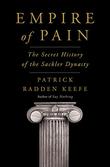Patrick Radden Keefe is a staff writer at the New Yorker and the author of three books, including Say Nothing: A True Story of Murder and Memory in Northern Ireland, which was a finalist for the 2019 Kirkus Prize and the winner of a National Book Critics Circle Award. His latest book is Empire of Pain: The Secret History of the Sackler Dynasty (Doubleday, April 13), which our reviewer called a “definitive, damning, urgent tale of overweening avarice at tremendous cost to society”; it earned a place on our list of the Best Nonfiction of 2021. Keefe answered some questions by email.
A lot of excellent books have been written about the opioid epidemic. Why did you want to write about the Sackler family?
It was through some of those terrific books that I first learned about the role the family played in the opioid crisis. But I wanted to write a different sort of story—not a full spectrum account of the opioid epidemic but a multigenerational saga about the rise and fall of one family, tracing the roots of the Sackler dynasty from the early days in Depression-era Brooklyn to the bitter legal endgame of recent years. It’s a book about the dark secrets behind a great American fortune, about philanthropy and greed and the profound mark that this family left on our world.
Empire of Pain is in many ways a very different book from your last one, Say Nothing, about the Troubles in Northern Ireland. Was there anything similar about the process of reporting and writing them, though?
On the surface, the books seem very different, but there are thematic similarities: Both books are interested in secrets and denial and the deceptive stories that people tell themselves and others in an effort to justify their own actions. And my process tends to be the same from project to project: intensive archival work and interviews, then a lot of effort to take all that research and distill it into a literary narrative that, if I’m doing it right, has real depth and momentum.
What was it like having a book come out in 2021? How did you connect with readers in this socially distanced year?
It was very strange! I had released a podcast at the outset of the pandemic, so I had some experience with the weird world of promoting something via Zoom. But after a couple of years working mostly in solitude on the book, sitting at my desk, staring at my computer, it was surreal to find that the “book tour” would entail…sitting at my desk, staring at my computer. Like winning a pie-eating contest in which the grand prize is more pie. But I was grateful for the opportunity to connect with readers, even remotely, and hugely encouraged by the warm reception to the book.
Who is the ideal reader for this book, and what do you hope they take away from it?
 One thing I remind myself of a lot when I’m writing is that I’m not writing for specialists. I’m not writing for the person who has already read a dozen books on this topic, or even for people who start with any particular interest in the ostensible subject of the book. Character and narrative can create a wonderful undertow that pulls the reader into worlds that she might never otherwise have entered, so, whether I’m writing about the Troubles in the 1970s or the opioid crisis today, my hope is to engage any reader who happens to pick up the book and read a few pages.
One thing I remind myself of a lot when I’m writing is that I’m not writing for specialists. I’m not writing for the person who has already read a dozen books on this topic, or even for people who start with any particular interest in the ostensible subject of the book. Character and narrative can create a wonderful undertow that pulls the reader into worlds that she might never otherwise have entered, so, whether I’m writing about the Troubles in the 1970s or the opioid crisis today, my hope is to engage any reader who happens to pick up the book and read a few pages.
What work of nonfiction most dazzled you this year?
It came out at the very end of last year, but one of the most dazzling and original nonfiction books I’ve read in years is Oak Flat: A Fight for Sacred Land in the American West by Lauren Redniss.



































